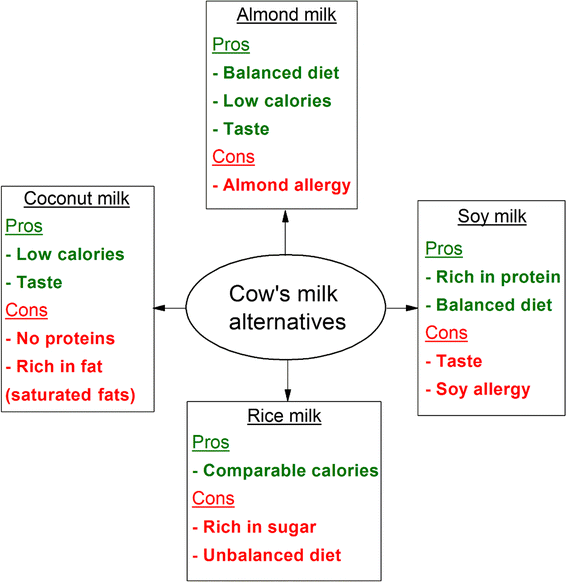You have a milk allergy, are a practicing vegan, or are perhaps lactose intolerant and drink a common milk alternative advertised to be healthy and nutritious. But how nutritious is it really?
A recent study from McGill University published in the Journal of Food Science and Technology looks at the four most-commonly consumed types of milk beverages from plant sources around the world – almond milk, soy milk, rice milk and coconut milk – and compares their nutritional values with those of cow’s milk.
The researchers compared the unsweetened versions of the various plant-based milks:
| Comparison of nutritional elements of milk alternatives based on averages for 240 ml serving | |||||
|---|---|---|---|---|---|
| TYPE | Calories | Fat | Protein | Carbohydrates | Calcium |
| Cow’s milk | 158 | 9.05 g | 8.11 g | 11.5 g | 294.2 mg |
| Soy milk | 95 | 4.5 g | 8 g | 4 g | 330 mg |
| Rice milk | 130 | 2.5 g | 1 g | 26 g | 315 mg |
| Coconut milk | 45 | 4.25 g | 0 g | 1 g | 220 mg |
| Almond milk | 35 | 2.5 g | 1 g | 1 g | 330 mg |
After cow’s milk, which is still the most nutritious, soy milk comes out a clear winner. Here is a summary from McGill:

Soy milk: most balanced nutritional profile
- Soy milk is widely consumed for its health benefits linked to the anti-carcinogenic properties of phytonutrients present in the milk known as isoflavones.
- Has been a substitute for cow’s milk for 4 decades.
- Concerns, however, are the ‘beany flavor’ and the presence of anti-nutrients (substances that reduce nutrient intake and digestion).
Rice milk: sweet taste and little nutrition
- Lactose free and can act as an alternative for patients with allergy issues caused by soybeans and almonds.
- Concerns, apart from the high carbohydrate count, is that consumption of rice milk without proper care can result in malnutrition, especially in infants.
Coconut milk: no protein and few calories, most from fat
- Widely consumed in Asia and South America
- Consumption can help reduce levels of harmful low-density lipoproteins (bad cholesterol) that are associated with cardiovascular diseases.
- Nutritional values are reduced if stored for over 2 months.
Almond milk: need for complementary sources of food to provide essential nutrients
- High content of monounsaturated fatty acids (MUFA) that are considered helpful in weight loss and weight management. MUFA also helps in reduction of low-density lipoprotein (bad cholesterol).
For comparison, here are the benefits and drawbacks of cow’s milk:
Cow’s milk: a wholesome, complete food, providing all major nutrients like fat, carbohydrates and proteins
- Can be helpful to humans by providing a wide range of host-defense proteins due to various beneficial anti-microbial effects found in both human and bovine milks. (E.g., a study shows that in the case of infants, consumption of cow’s milk has considerably reduced risk of fever and respiratory infections.)
- The presence of various pathogens like Salmonella spp and Escherichia coli O157:H7 in milk have been associated with disease outbreaks around the world.
Cow’s milk allergy and lactose intolerance
- One of the most common allergies among infants and children affecting 2.2-3.5% of children (a greater percentage than those who are affected by peanuts and tree nut allergies). As many as 35 % of these infants outgrow being allergic to milk by the age of 5-6, and this may increase to 80% by age 16.
- Lactose intolerance, due to the absence or deficiency of the enzyme lactase in the digestive tract, affects somewhere between 15-75 % of all adults depending on race, food habits and gut health.
- Some studies have suggested that 80% of people of African origin and 100% of those of Asian and Indigenous American origin are lactose intolerant.
The researchers advise that more work needs to be done to understand the effects of various conventional and novel processing methods on the nutritional profile, flavor and texture of these alternative milks.
- Nutritionally speaking, soy milk is best plant-based milk – McGill University Press Release
- How well do plant based alternatives fare nutritionally compared to cow’s milk? – Journal of Food Science and Technology







A major flaw of this study is the primary assumption that cows milk is beneficial for humans above the age of natural weaning. Cows milk is naturally designed for the rapid growth of calves, not human beings who have already transitioned to other sources of nutrition. This assumption has been pedalled as a false nutritional requirement by the dairy industry to support the demand for their product. So the basis for comparison is irrelevant and unnecesary. Lactose intolerance is not an enigma but a natural consequence of being above weaning age – our body stops producing the enzymes required to utilise/digest this sugar because over the age of three (approx) WE DON’T NEED MILK of any origin: human, cow, goat, camel, sheep, etc – milk is a nutrient rich food intended for the infacts of it’s own species. To mimic milk is a novelty and unecessary. So relax and drink your soy beverage, or just have a drink of water, because we’re grown ups and can eat solids now.